Nitrogen Uptake in Corn
Summary
- DuPont scientists are conducting extensive research designed to increase corn yields by improving the nitrogen use efficiency (NUE) of hybrids.
- Understanding nitrogen (N) uptake patterns is integral to improvement of corn NUE by scientists and optimal management of corn N supply by growers.
- Recent DuPont and university research gives new insights into the timing of N uptake and sources of N utilization by corn, including:
- N for grain development originates from both remobilized N from vegetative tissues and continued N uptake from the soil. Therefore, ensuring a season long N supply is critical for maximizing yield.
- By flowering (R1), corn has taken up approximately 63% of its N requirement for the season. The rest is taken up during the grain-fill period (R1 to R6). − With high yields, ~140 to 210 lbs N/acre is needed to support grain development. Approximately 38% of this demand is remobilized from vegetative tissue; the rest is supplied from continued uptake after flowering.
- In high yield environments, post-flowering N uptake can range from 85 to 130 lbs. N/acre.
- N applied closer to maximum crop use is less likely to be lost and more likely to be taken up by the crop and potentially available to support kernel set at flowering and late-season grain development.
- In-season soil N monitoring and the use of nitrogen use crop models could be a helpful tool to 1) alert growers about potential N shortfalls so action plans could be considered, and 2) guide N management plan modifications for future production years.
Importance of Nitrogen in Corn Production
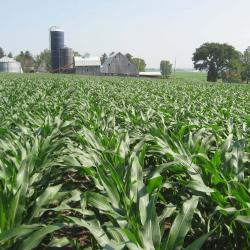
Nitrogen (N) is the most commonly applied nutrient and one of the costliest inputs in corn production. In fact, N application averages 18% and 13% of the variable costs in a corn-corn and corn-soybean rotation, respectively (Duffy 2014). Even so, its cost-to-benefit ratio usually exceeds that of other fertilizer inputs, but growers must use N efficiently to maximize its value. This means minimizing N losses by applying the appropriate rate, and timing applications to coincide with peak uptake by the crop. At the same time, growers must ensure that crop yield is not limited by insufficient N throughout the entire period of crop uptake. This article will highlight the importance of having a “season long N perspective” to ensure that crop N demands are met not only during rapid uptake, but also through the end of grain fill.
Increase in Nitrogen Use Efficiency
Average U.S. corn grain yields have more than doubled over the last half century, and N application rates have increased as well (Figure 1).
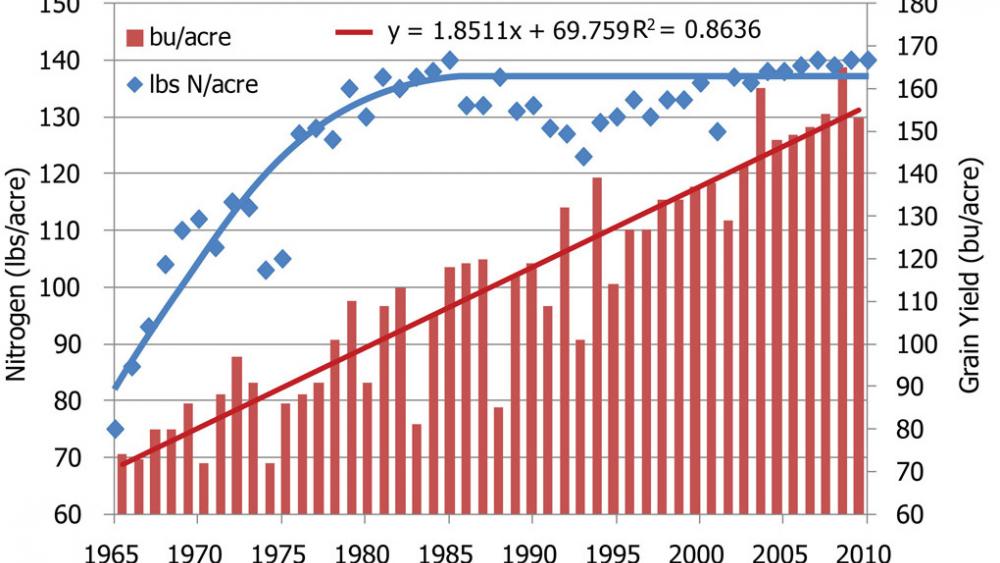
Figure 1. Historical grain yields and nitrogen application rates on corn acres in the U.S. Source: USDA.
Beginning in the 1980s, however, average N application rates have plateaued at about 140 lbs. N/acre, but corn yields have continued to increase (Figure 1). This increase in corn yields (by over 2 bu/acre per year since 1980), while N rates remained constant, indicates that nitrogen use efficiency (NUE, bu/lb N) has increased significantly. NUE increases are the result of improvements in both hybrid genetics and agronomic practices.
Grain Nitrogen Content
DuPont scientists are conducting extensive research to increase corn yields by improving the NUE of hybrids. Developing a clear understanding of corn N requirements at high and low yield levels and under various N supply conditions is integral to NUE improvements. As part of this research effort, a set of 20 hybrids were evaluated under high yield conditions near Sciota, IL, during 2012 and 2013. The objective of the study was to determine the grain N content of individual hybrids comprising a diverse sample of modern, elite corn genetics.
Yields ranged from 200 to 250 bu/acre in the study. The average protein content in this set of commercial hybrids was 9 to 10%. Nitrogen is a basic building block for all proteins in the plant and the grain, each unit of N supporting 6.25 units of protein production. In this high yield example, 1,060 to 1,260 lbs./acre of protein were produced. Converting this to a nitrogen basis, the grain removed approximately 140 to 210 lbs of N/acre.
The plant’s N demand for grain development is roughly proportional to the grain yield. A review of recent literature for modern corn hybrids indicates that at yields between 80 and 150 bu/acre, the demand is less than 65 lbs. N/acre (Table 2). When yields exceed 200 bu/acre, grain N removal averages 139 lbs. N/acre. The Iowa State University reference guide, Corn Growth and Development, reports an almost identical amount of N in the grain – 137 lb N/acre at yield levels of 225 bu/acre (Figure 3).
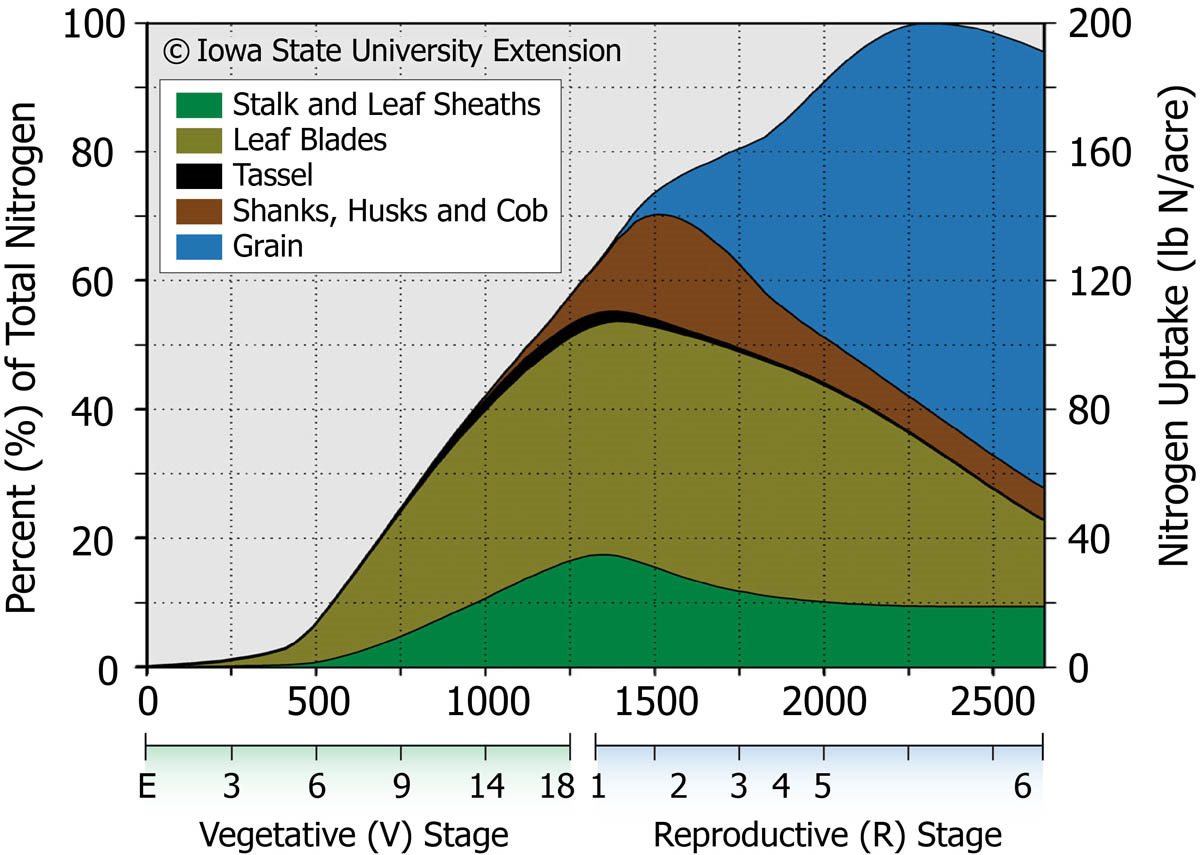
Figure 3. Seasonal N uptake (lbs N/acre) separated into leaf, stalk, tassel, husk+cob, and grain material for a typical corn crop. Abendroth et al., 2011.
Timing and Source of Nitrogen Uptake
The importance of N uptake prior to flowering cannot be overstated, as this N supports critical ear shoot development, kernel number and potential kernel size. For this reason, corn growers have traditionally targeted N availability to this period, and considered post-flowering applications to be of little value. Historical research with older, lower yielding hybrids also pointed to early application. In fact, many studies concluded that grain fill depended almost entirely on remobilized N from the leaves and stalk, and that post-flowering N uptake contributed little to yield accumulation.
However, extensive research conducted over the last five years has shown that nitrogen needed for grain development originates from both remobilized N (from leaves, stalks, cobs and husks) and continued N uptake from the soil. Research studies include those conducted by DuPont and university scientists.
A DuPont study was conducted at Macomb, IL, in 2012, comparing a “normal” rate of 200 lb N/acre with a “low” rate of 50 lb N /acre. Resulting yields averaged 250 bu/acre for the normal rate, and 100 bu/acre for the low N rate. In the normal N environment, 130, 170, and 301 lbs N/acre were taken up by V12, R1 and R6, respectively (Figure 4). Of the 195 lb N/acre contained in the grain at maturity, 63 lbs were sourced from remobilized N (from leaves, stalks, etc.) and 132 lbs were from N taken up post-flowering (Figure 4).
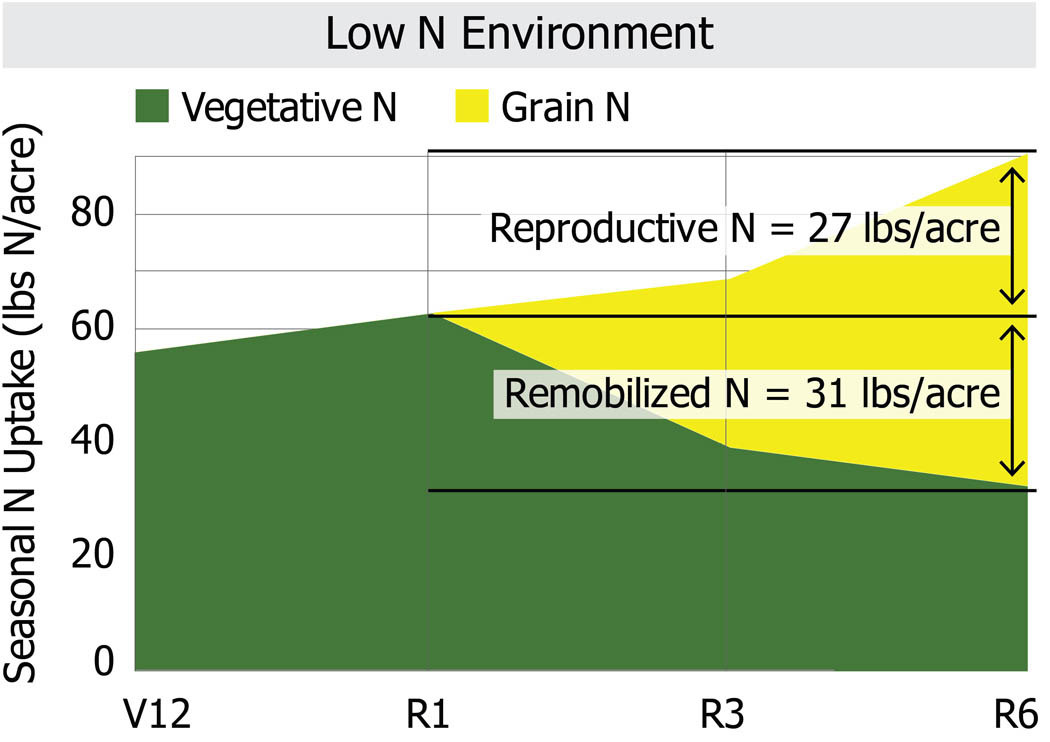
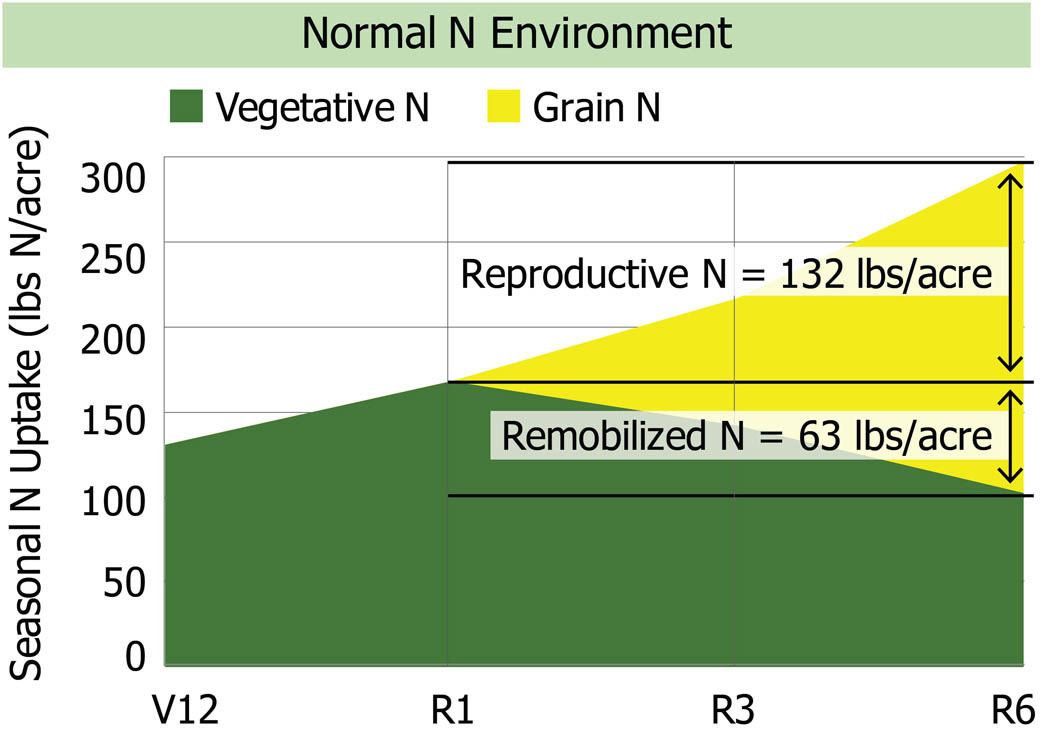
Figure 4. Seasonal N uptake (lbs N / acre) for commercial hybrids grown under normal N (top) and low N (bottom) supply near Sciota, IL, during 2011.
In the low N environment (100 bu/acre yield level), N uptake was limited to 60 lbs/acre by R1, and only 27 lbs/acre were taken up post-flowering (Figure 4). These reduced N levels simulate conditions when the pool of available N is low due to leaching, denitrification or under-application of N.
In cases of low N availability when post-flowering N uptake cannot fully support grain development, the remaining nitrogen comes from N remobilized from the vegetative tissues (stalk, leaves, husks and cob). The leaves are the most substantial source of remobilized N. Based on recent publications from experiments conducted in IL and IN, the amount of N remobilized from vegetative tissue averages 38% across all yield levels with a maximum of 54% under high yield, high N conditions (Table 2). In a recent publication by DeBruin et al., (2012) two independent studies documented that a maximum of 63% of the leaf N could be remobilized to the grain. Further work by DuPont documented that the stalk generally contributes less than 20% of the remobilized N to the grain and that contributions from the cob and husks are insignificant.
Several university studies evaluated timing of N uptake. In Iowa State studies, approximately 60% (120 lbs N / acre) of total N (Figure 3) was taken up and stored in the leaves, stalk and ear shoot by R1 (silking) for a high-yielding corn crop of 225 bu/acre corn (Abendroth et al., 2011). By R6 (black layer), total N uptake (stover + grain) reached 190 lbs N/acre. Further calculations with these data indicate that 70 lbs of N/acre must still be taken up post-flowering to support grain development.
Other recent publications document the amount of N taken up by flowering and after flowering (Appendix – Figure 5 and Table 2) These data suggest that the total N taken up by flowering is almost identical under low or normal N conditions (averaging 63% and 62%, respectively). While this is a large proportion of total seasonal N, the demand for post-flowering N uptake still ranges from 39 to 132 lbs N/acre.
Examples of the importance of post-flowering N uptake can be found in Table 2. In two environments in IL and IN with yields greater than 220 bu/acre, plant N uptake by R1 reached 168 lbs N/acre. Since a maximum of 54% of preflowering vegetative N was found to be remobilized in high yield conditions, only 91 lbs N/acre would be available for grain filling. Assuming a grain protein content of 8%, this amount of N would only support a 127 bu/acre corn crop. Thus, corn yield would be clearly limited if the crop were completely dependent on remobilized N for filling the grain, especially in fields where the soil N pool has been depleted by environmental loss or under-application. It is clear from Table 2 that modern hybrids also depend on substantial N uptake post-flowering to support grain formation.
N Uptake Patterns – Old vs. New Hybrids
One reason for misconceptions about post-flowering N uptake and its contribution to grain fill is that modern, higher yielding hybrids have different N use patterns. Research in the past few years has documented that newer hybrids take up additional nitrogen post-flowering compared to older hybrids. Recent work by Ciampitti and Vyn (2012) summarized 100 scientific reports covering old (1940 to 1990) and new (1991 to 2011) hybrids (Table 1). The summary shows that, on average, new hybrids took up an additional 7 pounds of N over the season. The timing of N uptake is even more significant – new hybrids took up 29% more N post-flowering than old hybrids (Table 1).
Nitrogen uptake trends were further documented by Haegele (2013), who compared 1970-era hybrids to hybrids released after 2000 (Table 1). This study showed that new hybrids took up an additional 8 pounds over the season and accumulated 40% more N post-flowering than older hybrids (Table 1). Evaluation of DuPont brand hybrids marketed from 1934 to 2013 supports these findings that additional N is taken up by new hybrids and that a larger fraction of total N is taken up post-flowering. As a result, researchers, agronomists and growers may need to reevaluate recommendations for timing of N applications and maintaining adequate N supply throughout corn’s reproductive period.
Table 1. Nitrogen uptake timing and quantities for old and new hybrids.
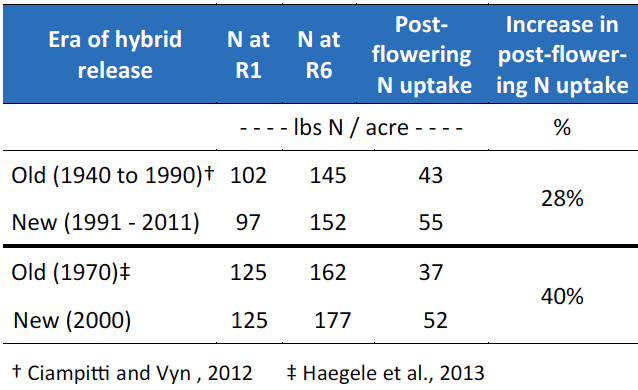
Nitrogen Management Plan for the Long Haul
In most production systems, grain development (starting at pollination) begins about 75 to 95 days after planting, depending on hybrid maturity (CRM). However, the majority of N is typically applied just prior to planting or even 4 to 5 months ahead of planting (in the fall). N management programs are largely driven by workload management and N price, and partially by crop demand (e.g., split applications during the season), but rarely by accounting for late-season crop N uptake.
Ensuring there is a pool of soil N available during the late stages of grain development is the most difficult aspect of an N management plan. This is because late N availability is dependent on many complex and interacting factors, including:
- Initial N application rates and timing.
- Mineralization of soil organic matter, which provides N in plant-usable forms.
- Environmental factors that affect volatilization, leaching, denitrification and mineralization.
- Crop uptake during the vegetative period.
- Crop yield potential.
Losses due to volatilization and leaching may range from 0 to 50 lbs./acre/year depending on the growing environment. Denitrification losses may be as high as 2 to 5% of the total soil N per day if soils are saturated. Crop uptake during the vegetative period generally ranges from 1 to 2.8 lbs./acre per day. Because N is easily lost from the soil and may be taken up quickly by a fast-growing corn crop, planning for post-flowering soil N availability is challenging. In fact, the confidence level in predicting the supply of soil N for grain filling declines as the interval between N application and grain development increases.
Current N application strategies target application in the fall or the spring prior to crop planting. Having a supply of N during vegetative development is clearly important, because greater than 60% of the N is taken up and stored prior to flowering (Appendix – Figure 5). However, only a third of that N is generally remobilized to support grain development. In high-yield environments where the grain N demand exceeds 200 lbs. N/acre, the importance of available late-season N is magnified.
Based on recent research findings regarding pre- and post-flowering N uptake as well as N remobilization, a logical strategy is to build a nitrogen application plan that mirrors crop demand to limit losses and maximize N uptake:
- Application of 70% of the total seasonal N requirement prior to planting should provide sufficient N for vegetative growth.
- Applying the remaining 30% as late during the growing season as equipment allows would likely be advantageous most years.
- This planned late application also provides the option of replacing N lost due to high rainfall conditions typical in May and June in many locations.
Another option is adding a nitrification inhibitor to the late application to help delay N release until closer to flowering or after flowering. This option depends on soil N availability at the time of application, as well as the time of application relative to the crop development stage. A recent report documented that the addition of nitrapyrin (e.g., Instinct® nitrogen stabilizer) in pre-plant and side-dress applications of N increased N uptake during the season (Burzaco et al., 2013). Although the yield increase was non-significant, these N applications with nitrapyrin increased NUE by 17% and nitrogen recovery by 25%.
Conclusions
Evaluation of your N plan is essential to maximizing yield and minimizing N cost. The largest unknown in the system is documentation of the soil N pool that is available for crop uptake. Environmental and cultural parameters that directly impact the soil N pool are rainfall, temperature, soil type, and N application dates and amounts. By including these parameters in environmental models, an estimate of available N can be calculated. Comparing crop growth and development to projected yield potential can further identify whether available soil N will meet crop demand for aggressive yield targets. Crop model based services are just beginning to be implemented in corn production areas and have received a high degree of interest from growers.
Contact us to learn more about nitrogen uptake in corn.
Resources
Abendroth, L.J., R.W. Elmore, M.J. Boyer, and S.K. Marlay. 2011. Corn growth and development. PMR 1009. Iowa State University Extension and Outreach, Ames, Iowa.
Bender, R.R., J.W. Haegele, M.L. Ruffo, and F.E. Below. 2013a. Transgenic corn rootworm protection enhances uptake and postflowering mineral nutrient accumulation. Agron. J. 105-1626-1634.
Bender, R.R., J.W. Haegele, M.L. Ruffo, and F.E. Below. 2013b. Nutrient uptake, partitioning, and remobilization in modern transgenic insect-protected maize hybrids. Agron. J. 105-161-170.
Burzaco, J.P., I.A. Ciampitti, and T.J. Vyn. 2013. Nitrapyrin impacts on maize yield and nitrogen use efficiency with spring-applied nitrogen: field studies vs. meta-analysis comparison. Agron. J. 105:1-8.
Ciampitti, I.A., and T.J. Vyn. 2011. A comprehensive study of plant density consequences on nitrogen uptake dynamics of maize plants from vegetative to reproductive stages. Field Crops Research 121:2-18.
Ciampitti, I.A., and T.J. Vyn. 2012. Physiological perspectives of changes over time in maize yield dependency on nitrogen uptake and associated nitrogen efficiencies: a review. Field Crops Research 133:48-67.
Ciampitti, I.A., S.T. Murrell, J.J. Camberato, M. Tuinstra, Y. Xia, P. Friedemann, and T.J. Vyn. 2013. Physiological dynamics of maize nitrogen uptake and partitioning in response to plant density and nitrogen stress factors: II. reproductive phase. Crop Sci. 53: 2588- 2602.
Ciampitti, I.A., and T.J. Vyn. 2013. Grain nitrogen source changes over time in maize: a review. Crop Sci. 53:366-377.
DeBruin, J., C.D. Messina, E. Munaro, K. Thompson, C. ConlonBeckner, L. Fallis, D.M. Sevenich, R. Gupta, and K.S. Dhugga. 2013. N distribution in maize plant as a marker for grain yield and limits on its remobilization after flowering. Plant Breeding 132:500-505.
Duffy, M., 2014. Estimated costs of crop production in Iowa – Ag Decision Maker FM 1712. Iowa State University, Ames, Iowa.
Haegele, J.W., K.A. Cook, D.M. Nichols, and F.E. Below. 2013. Changes in nitrogen use traits associated with genetic improvement for grain yield of maize hybrids released in different decades. Crop Sci. 53:1256-1268.
Luce, G., and J. Mathesius. 2010. Hybrid response to nitrogen fertilizer: are there differences. Crop Insights Vol. 19, no. 6. DuPont, Johnston, IA.
Authors
- Jason DeBruin, Research Scientist, DuPont, Macomb, Illinois.
- Steve Butzen, Agronomy Information Manager, DuPont, Johnston, Iowa.
[Content Feature]
Appendix
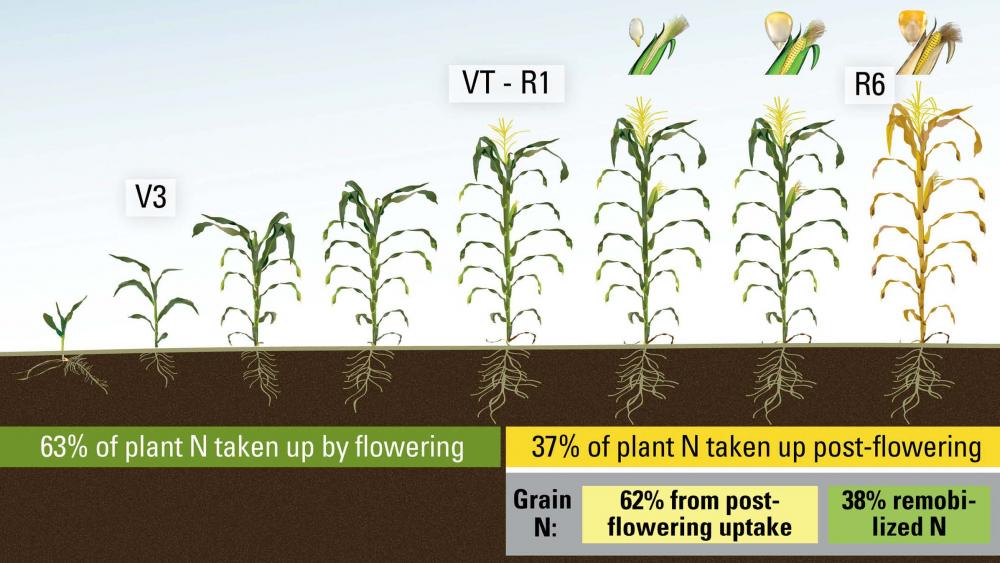
Figure 5. Percent of N taken up by the plant before and after flowering, and percent of N in the grain from post-flowering (after VTR1) uptake and remobilized sources.
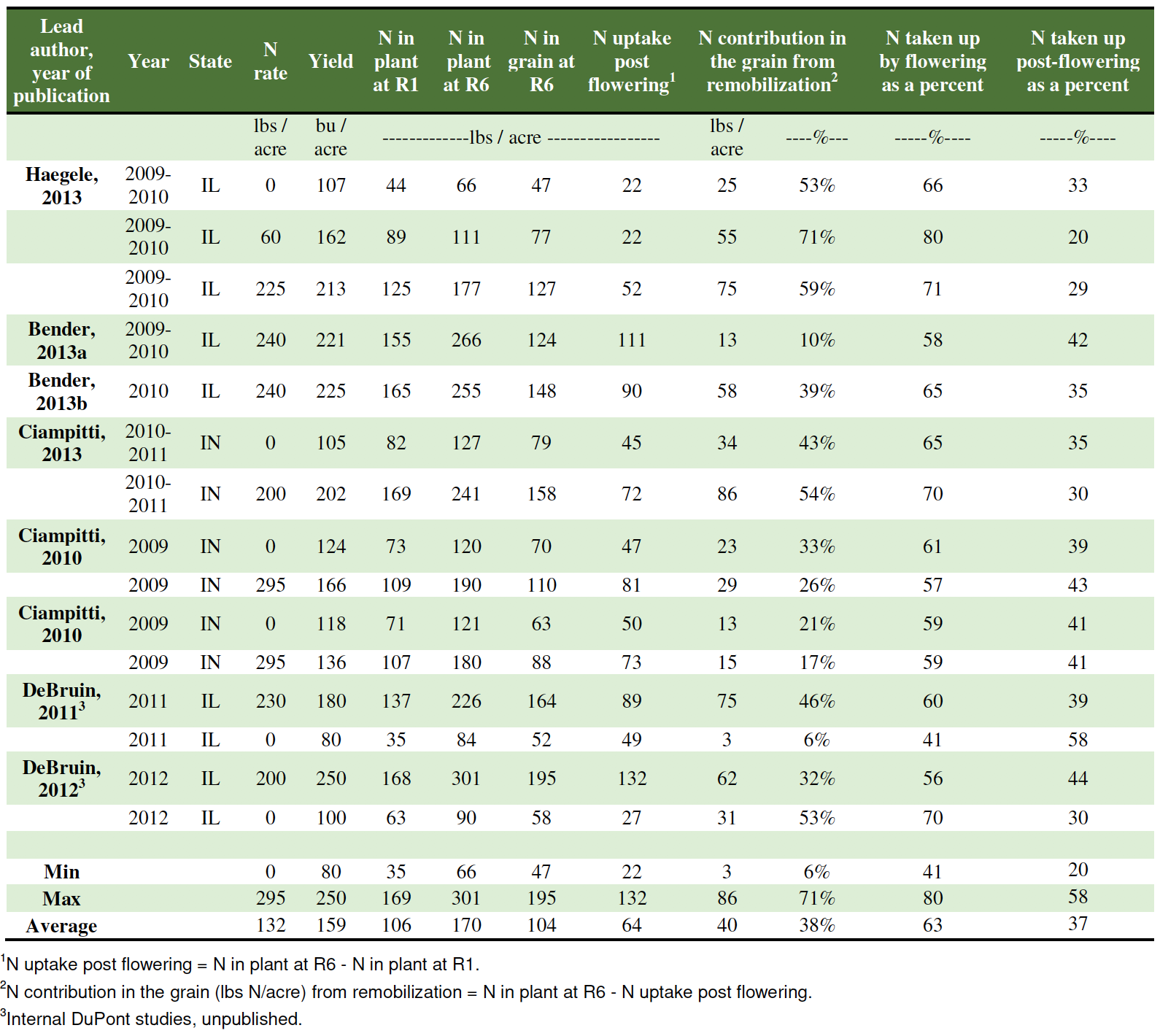
Table 2. Summary of plant N uptake at R1 and R6, grain N uptake at R6, N uptake post flowering, and the percent of plant N taken up post flowering along with the percent of grain N contributed by N remobilization from vegetative tissue for recent publications from studies conducted in IN and IL between 2009 and 2012.
1N uptake post flowering = N in plant at R6 - N in plant at R1.
2N contribution in the grain (lbs N/acre) from remobilization = N in plant at R6 - N uptake post flowering.
3Internal DuPont studies, unpublished.
